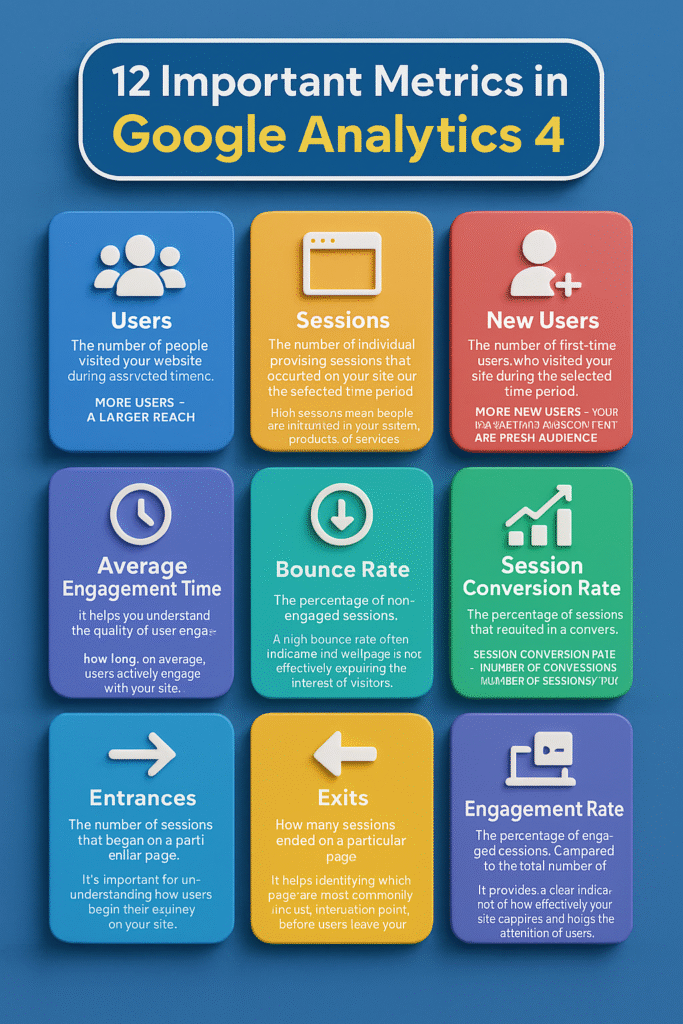

GA4 Metrics to Track for Better Website Performance
Google Analytics 4 (GA4) introduces a smarter way to evaluate user behavior with powerful metrics that help businesses make more informed decisions. Whether you run an e-commerce store, service-based website, or blog, these GA4 metrics provide clear insights into what’s working and what needs improvement.
This guide breaks down the 12 most important GA4 metrics—what they mean, why they matter, and how they can help improve your marketing performance.
Table of Contents
Toggle12 most important GA4 metrics

1. Users – Measuring Your Website’s Total Audience
What it means:
Users represent the number of people who visited your website during a selected timeframe.
Why it matters:
Tracking users helps you understand the size of your audience and monitor growth over time. More users indicate higher reach and better awareness for your brand.
2. Sessions – Understanding User Interest
What it means:
Sessions show how many individual browsing sessions occurred on your website.
Why it matters:
Sessions measure engagement beyond simple visitors. A high number of sessions indicates that users are genuinely interested in exploring your content, products, or services.
3. New Users – Measuring Fresh Traffic
What it means:
New Users are people who visit your website for the first time during a selected period.
Why it matters:
If your New Users metric is high, your SEO, social media, and marketing campaigns effectively attract new audiences. It’s a strong signal of brand visibility and growth.
4. Average Engagement Time – Quality of User Interaction
What it means:
This metric tracks how long, on average, users actively engage with your website.
Why it matters:
Higher engagement time indicates your content is appealing and relevant. If engagement time drops, it may indicate poor UX, weak content, or slow page speed.
5. Bounce Rate – Tracking Non-Engaged Sessions
What it means:
Bounce rate is the percentage of sessions where users did not engage with your content.
Why it matters:
A high bounce rate may mean your website isn’t capturing interest or fulfilling user intent. It may require improvements such as better content, improved UI/UX, or faster loading.
6. Session Conversion Rate – Measuring Marketing Success
What it means:
Session Conversion Rate = (Number of Conversions / Number of Sessions) × 100.
It shows the percentage of sessions that resulted in a conversion
Why it matters:
This metric evaluates how effective your website and marketing campaigns are at driving desired actions—such as form submissions, purchases, or sign-ups.
7. Entrances – Where Users Start Their Journey
What it means:
Entrances reveal how many sessions started on a specific page.
Why it matters:
It helps identify key landing pages and understand which pages attract the most initial user attention.
8. Exits – Where Users Leave the Website
What it means:
Exits determine how many sessions end on a particular page.
Why it matters:
Tracking exit pages helps identify where users drop off. High exit rates on the wrong pages could signal content gaps or UX issues.
9. Views Per User – Measuring Content Depth
What it means:
This metric shows the average number of pages a user views during their visit.
Why it matters:
Higher views per user indicate strong internal linking, good content flow, and strong user intent. It means users want to explore more of what you offer.
10. Engaged Sessions – Tracking Meaningful Interactions
What it means:
A session is considered “engaged” if it meets any of the following:
lasts longer than 10 seconds,
includes at least two page views,
triggers a conversion event.
Why it matters:
More engaged sessions indicate your website content aligns well with user expectations and encourages them to stay longer.
11. Engagement Rate – A Clear Indicator of Website Performance
What it means:
Engagement Rate is the percentage of engaged sessions compared to total sessions.
Why it matters:
It shows how well your website holds users’ attention. A higher engagement rate is a sign of better user experience and effective content strategy.
12. Returning Users – Understanding User Loyalty
What it means:
Returning Users are people who visit your site more than once during the selected timeframe.
Why it matters:
Tracking returning users helps you measure:
User retention
Customer loyalty
How well you convert new users into repeat visitors
The strength of your brand and content strategy
Why These GA4 Metrics Matter for Businesses
Understanding these GA4 metrics helps businesses:
✔ Improve website performance
✔ Optimize customer journeys
✔ Enhance engagement and retention
✔ Drive more conversions
✔ Strengthen marketing and SEO strategy
By analyzing these metrics regularly, brands can create data-driven strategies that improve user experience and increase profitability.
How GA4 Supports EEAT (Experience, Expertise, Authoritativeness, Trustworthiness)
Using GA4 metrics strengthens your website’s EEAT because:
Experience: You understand real user behavior and optimize based on real insights.
Expertise: You rely on accurate analytics to improve content and user journeys.
Authoritativeness: Better engagement and returning users help build domain authority.
Trustworthiness: Improved UX and conversion paths boost trust and credibility.
Final Thoughts
Google Analytics 4 provides a powerful set of metrics that help businesses track performance, understand user behavior, and make smarter decisions. By mastering these 12 important GA4 metrics, you can optimize your website, enhance engagement, and improve conversions more effectively.






















Post Comment